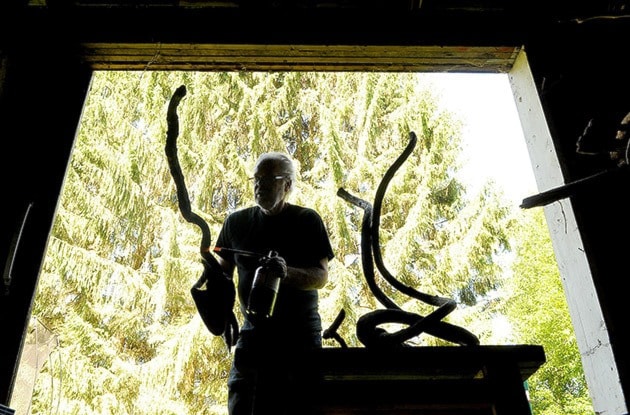Maxwell Newhouse thought he created something completely unique.
Always needing to reinvent himself, he wanted to try something new, so he began burning pieces of his driftwood collection last winter, on New Year’s Eve.
“In my own little world, I thought that I invented something brand new,” he said. “I thought if I can burn this and come up with a finish that’s black — and one of the most popular trends is white rooms with white walls — I thought this black furniture would fit beautifully.”
Turns out Newhouse didn’t invent the charred wood finish. The Japanese did. Hundreds of years ago.
It’s called shou suji ban which literally translates to ‘burnt cedar board’. It’s a Japanese technique that’s been around for more than 300 years. The reason it’s so successful is because it causes the wood to be fire resistant, insect resistant, and the black finish will last 80 years.
The Japanese use shou suji ban for residential housing, such as on roof shingles and siding. Newhouse uses the technique on his driftwood furniture.
He burns each piece of wood four times with a blowtorch.
“The first burn you have to wear a mask because there’s soot everywhere. I’m dirty from head to toe, and I look like a chimney sweep,” he says.
“By the time I get to the fourth burn, there’s no soot at all. I don’t understand what I’m doing, I just know it works. Then, I have a secret treatment where everything is set in so that the colour cannot be transferable.”
“You can sit on it in a white wedding dress and you’d be fine,” he adds.
He calls it carbon furniture.
“It’s hard for people to appreciate it because it’s hard to get around the fact that it’s burnt. The black isn’t like a paint or a coating. It’s actually part of the wood, it’s in the wood, and it’s permanent,” he said.
“When it’s just the (unburnt)wood, the colours are very beautiful and you become distracted by the wood alone. However, when it’s just pure black, you have a tendency to pay attention to pure form.”
The repurposed wood he uses comes from bonfires or off the beach. He loves searching for driftwood on Vancouver Island — his favourite spot is Campbell River.
The driftwood is “something no one wants, and I like that,” he said. “The wood can even be rotten because I can burn right to the point where I get to the fresh wood which makes it even more interesting.”
Newhouse has a eureka-like moment, as if he’s found gold, whenever he finds the right piece of driftwood.
“I find a piece and I’m stunned by its beauty. I sneak away like a thief; like a hoarder. I don’t even have to use it; it can just sit there and I can look at it and I’m happy.”
He has a workshop full of driftwood, stacked from floor to ceiling, that he’s collected over the years.
“I’ve burnt myself into a corner because I’ve made so many pieces of furniture and no one knows about it,” he said.

But now, his carbon furniture is on its way to becoming known by many.
Newhouse was recently commissioned by the City of Burnaby to build a large stand-up bass out of driftwood. It’s 10.5 ft. tall and weighs about 200-250 lbs. Though the piece is not made entirely out of burnt wood, he has added a couple of charred driftwood pieces into the bass, which is now on display at the PNE along with a large harp and drum he made last Christmas.
Folks can check out Newhouse’s driftwood furniture called ‘eco sculptures’ located on Miller Drive on the PNE grounds in between the entrance to horse racing track and behind the livestock building.
“I like that I’m using pieces that I’ve had for 10 years, and that I finally found a place for them,” said Newhouse.
“I like that Burnaby points me in different directions. They come up with ideas that I would have never imagined and that’s what an artist needs: someone to push them to where they think they can’t go.”
photo@theprogress.comtwitter.com/PhotoJennalism

